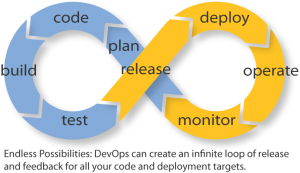We’ve discussed the challenges and complex problems DevOps encounters in an asymmetric environment, so let’s flip the script and discuss the efficiencies and improvements a symmetric environment can offer in DevOps. Before we do that, let’s review DevOps again and the definition of symmetry.
DevOps: This is a software development method that is based on the idea of collaboration, cooperation, and communication between a team of software developers and other arms of an IT organization within an enterprise.
Symmetry: similarity or exact correspondence between different things
In Part 1 of our series we stated DevOps should be a managed asset for enterprise business and that a symmetric environment maximizes efficiency, predictability, security and the overall operational processes. So how do you get a symmetric environment when you don’t have the money for another build out? How do you achieve a symmetric environment when all you have time for is to “code for the exceptions” and hope for the best when it’s time for the rollout? Moving from an asymmetric to symmetric environment takes planning and expertise. Typically, DevOps teams either don’t have the time to take on such a huge project nor do they have the sophistication and expertise in-house to execute it. Because of these two large factors, Net3 Technology has developed Symmetry DevOps ™ powered by Palmetto Virtual Data Center (PvDC) to streamline dev to production and improve business practices.
Symmetry DevOps ™ is a development method that is specifically designed to complement and enhance existing SDLC (Software/System Development Lifecycle) practices where they exist, and provide a robust and scalable platform where nothing exists currently.
With Symmetry DevOps ™, the entire production environment is replicated or cloned. This means:
- Identical production settings/configurations while maintaining logical separation for Dev/Test/etc. needs.
- Data and configuration can easily flow from one environment to another, maintaining quality and consistency in all environments through out the process.
- Developer productivity is enhanced by removing need to code for separate environments that are not in production.
- Easily automate the controlled flow of data/configurations from environment to environment.
Wrapping these processes in PvDC allows the SDLC to be in continuous flow. Information from each DevOps group is synced much more rapidly and completely than ever before, which provides more opportunity for maximizing cooperation between groups. Symmetry DevOps ™ also allows businesses to do more with less. Infrastructure, licensing, staff, etc. are all very real costs that can be greatly reduced. With Symmetry DevOps ™, each customer is provided with multiple, customer defined, isolated environments with the customer’s full data set in each.
Symmetry DevOps ™ Benefits include:
- Consistent build process resulting in simplified approach and the reduced possibility for human error.
- Better management and control over environments (Operating Systems, Patch levels between development phases, computing, network).
- Achieve automation for rapid deployment and delta change between each deployment phase.
- Reduced time for build deployments for all environments.
- Increased code reliability in all environments.
Today’s pain points in DevOps no longer have to be a challenge. There is finally a platform out there to maximize and streamline both cooperation and production in DevOps. To demo PvDCs Symmetry DevOps platform, visit https://demo.palmettovdc.com or contact us at 1-864-990-0112 to discuss your current needs and goals.
Connect with us next week as we discuss the number one reason why enterprise businesses are reluctant to move to the cloud: Control. PvDC not only allows you to have it, but the way you want it too. Part 3 of our series: “The Impact of having greater control over DevOp’s environmentals”.

